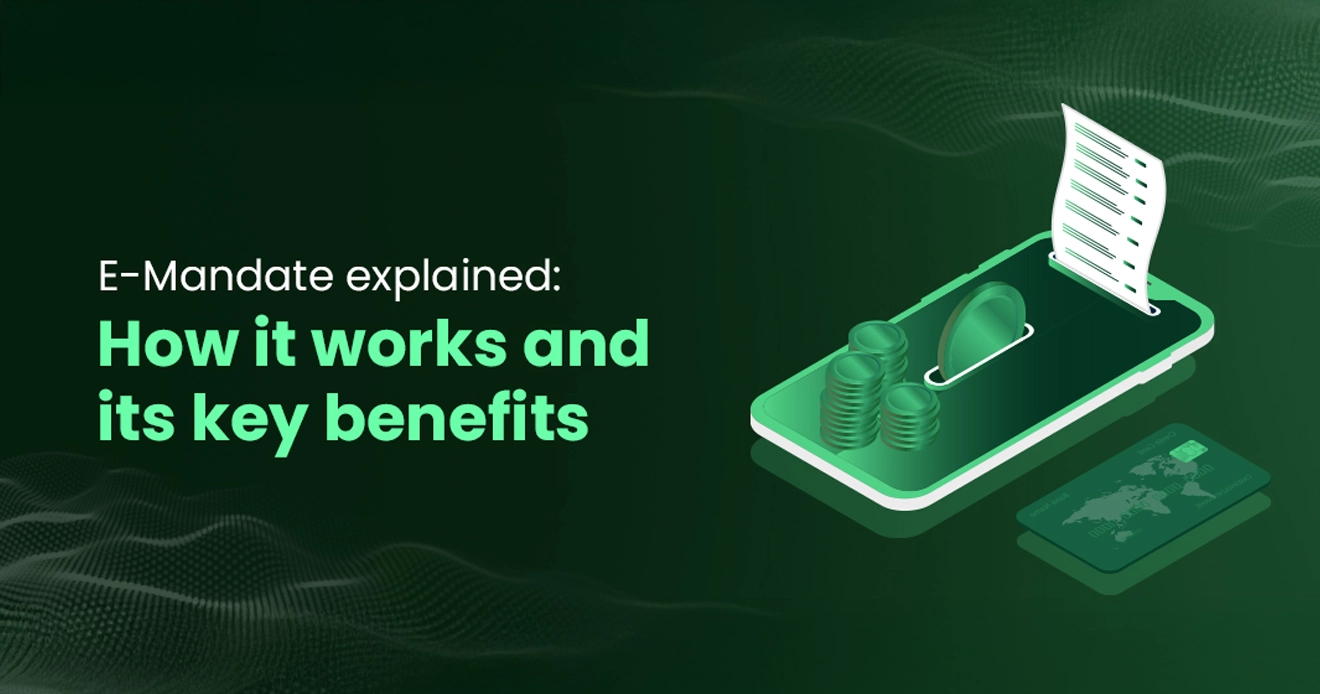Convenience is crucial in the dynamic landscape of modern commerce in India. People seek ways to
streamline their lives, and technology is at the forefront of this transformation. A prime
example of this is the e-mandate, which has transformed the process of handling recurring
payments in India.
Solving the issue of missed payments, an e-mandate ensures your bills are paid on time, every
time, without the hassle of manual transactions. This automated solution is not only time-saving
but also reduces the risk of late fees and service disruptions. As more people embrace digital
financial tools, the e-mandate is becoming an essential part of managing finances efficiently.
It offers a glimpse into a future where our financial responsibilities are seamlessly integrated
into our digital lives, providing peace of mind and convenience. This blog will delve into how
the e-mandate is reshaping the financial landscape, offering a convenient, secure and reliable
solution for recurring payments.
What is an e-mandate?
The e-mandate is a digital payment service introduced by the Reserve Bank of India and the
National Payments Corporation of India (NPCI). It provides a framework for businesses to collect
recurring payments automatically.
A mandate is an instruction given to your bank to allow automatic debits from your account. This
system simplifies the management of recurring payments like insurance premiums, SIPs, and loan
installments, removing the need for paperwork and manual processing.
Unlike the older system requiring signed physical forms, e-mandate is quick and efficient,
leveraging API-based eNACH technology introduced by NPCI in 2018. This innovation ensures
hassle-free, timely payments without the risk of penalties.
How does e-mandate work?
Understanding the steps involved in setting up an e-mandate can help you appreciate its efficiency and convenience. Here’s a breakdown of each step, from initial consent to the final recurring payment instruction, to give you a clear picture of how this system works:
Step 1: Consent
The first step in setting up an e-mandate involves the customer permitting automatic deductions
from their bank account. This consent can be provided through various methods, such as filling
out forms, visiting websites, or using mobile apps. During this process, the customer selects
the payment amount, frequency, and duration, ensuring they have control over the specifics of
the recurring payments.
Step 2: Authentication
Once the customer has given their consent, the next step is to verify and authenticate the
e-mandate. This is done using net banking credentials or debit card details. Authentication
ensures that the customer is indeed the owner of the bank account and agrees to the terms and
conditions of the e-mandate. This step adds a layer of security, making sure the process is both
safe and reliable.
Step 3: Validation
In the validation step, the National Payments Corporation of India (NPCI) plays a crucial role as
an intermediary. NPCI is a non-profit organization that facilitates digital payments and
settlements across India.
It verifies the details provided by the payer and the request made by the payee. This validation
step ensures that all information is accurate and that the e-mandate can be processed smoothly.
Step 4: Recurring payment instruction
After validation, the customer’s bank sets up the recurring payment instructions. This setup
allows the bank to automatically deduct payments on the specified due dates. The customer will
receive a confirmation message and can check the status of their e-mandate through their bank’s
portal or app.
This transparency helps customers stay informed about their payment schedules and account
activities. Customers have the flexibility to cancel the e-mandate at any time by contacting
their bank or the payee. In the event of any disputes or issues, NPCI mediates to resolve them,
ensuring compliance with regulatory guidelines and maintaining trust in the system.
Types of e-mandates
e-mandates come in various forms, depending on the payment method selected. Here are two
prevalent types:
- Debit card e-mandate
- Credit card e-mandate
With a debit card e-mandate, you can link your debit card
to a merchant or service provider and authorize them to deduct a fixed or variable amount
from your bank account at regular intervals. The transaction limit for a single debit card
e-mandate is ₹15,000. If the transaction amount exceeds ₹15,000 or the cardholder’s limit,
an additional factor of authentication (AFA), such as an OTP, is required. The maximum limit for a single transaction via
debit card e-mandate in India is ₹1 lakh.
A credit card e-mandate allows you to connect your credit card to a merchant or service
provider and authorize them to charge a fixed or variable amount to your card at specified
intervals. As of March 2024, the limit for e-mandates on credit card bill payments is ₹1 lakh
per transaction without the
need for additional factor authentication.
This limit also applies to other categories like mutual fund subscriptions and insurance
premium payments. By using an e-mandate, both debit and credit cardholders can streamline
their recurring payments, making transactions seamless and efficient. These types of
e-mandates eliminate the need for manual intervention, ensuring timely and hassle-free
payments.
Why is e-mandate beneficial?
Ever since it was introduced, e-mandate has been growing progressively and offers real-time
authorisation confirmation. These improvements have made it easier for many industries to adopt
the recurring payment model. Here are some major benefits of e-mandates:
- Enhancing customer retention
- Smoother payment process
- Lower administrative costs
- Efficient auto-reconciliation
- Simplified enrolment
- Flexible payment plans
e-mandate gives businesses the flexibility to manage
customer debits. This allows for changes in the payment cycle or even skipping a cycle if
needed, enhancing the overall user experience.
One-time digital authentication enables automatic
debiting from your customer’s bank account, ensuring they enjoy uninterrupted services. This
not only boosts customer loyalty but also enhances retention over time by eliminating the
need for constant payment reminders.
e-mandate simplifies recurring payments by allowing
businesses to auto-debit customer accounts. This reduces the friction of customers having to
log in to make payments, ensuring continuous cash flow for the business.
With auto-debit functionality, businesses no longer
need to chase customers for payments. This significantly cuts down on operational efforts,
invoicing tasks, and overall administrative costs.
Since most transaction details are tracked and
captured online, the time, effort, and money spent on acquiring and maintaining multiple
tools are greatly reduced. This makes the reconciliation process more efficient.
The process is straightforward, requiring only an active
bank account and card details for a one-time enrollment. This provides customers with a
lifetime of hassle-free service.
India’s changing payment landscape?
The digital world is reshaping how we handle everyday tasks, and payment systems are no
exception. The advent of e-mandate has brought a new level of convenience, transforming how we
manage recurring payments. Its streamlined process eliminates the hassle of manual interventions
and ensures smooth, uninterrupted transactions.
This shift not only simplifies life for consumers but also for businesses with a reliable and
efficient payment solution. As technology continues to advance, tools like e-mandate are paving
the way for a future where managing finances is easier, efficient and user-friendly.

